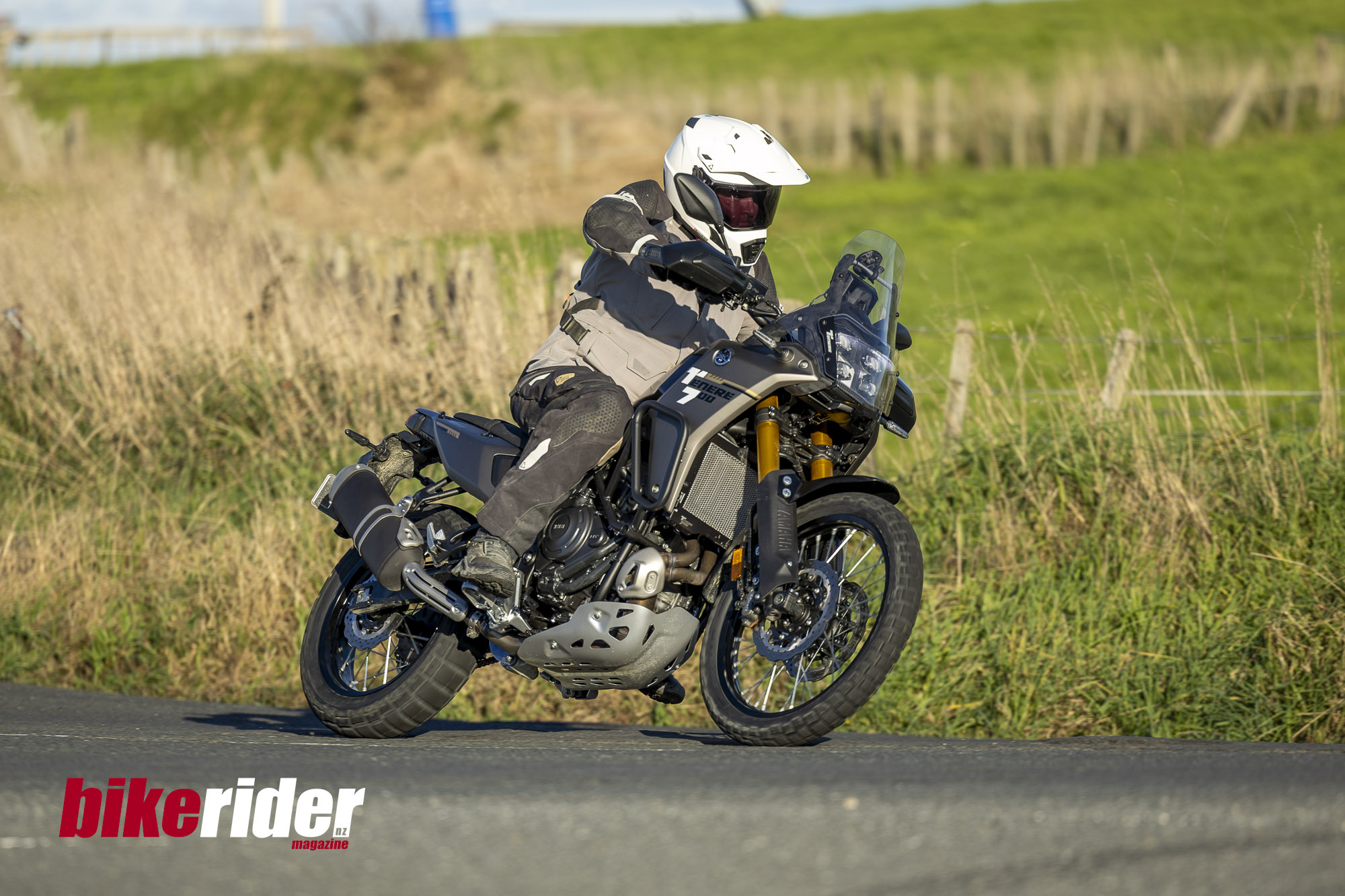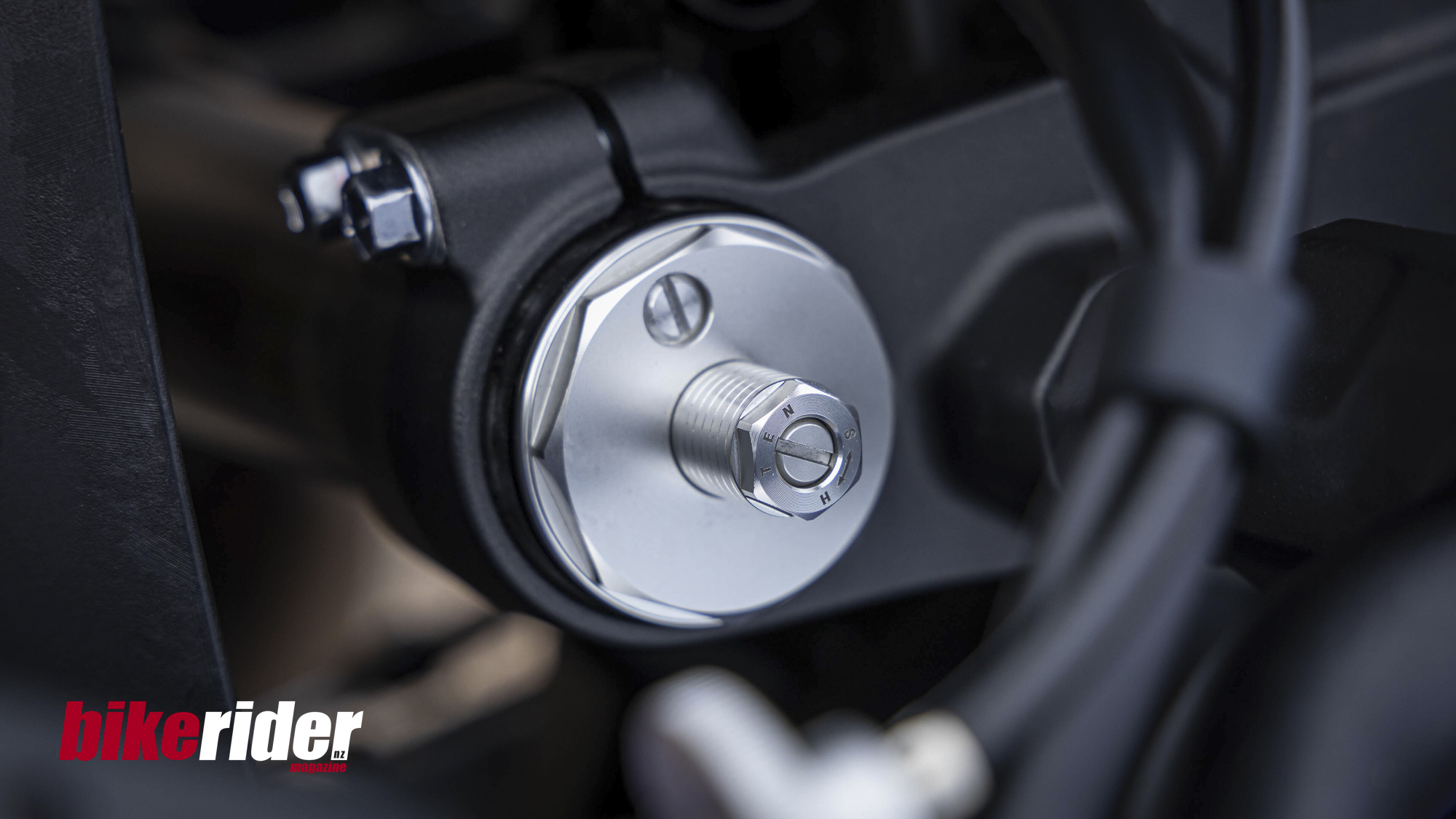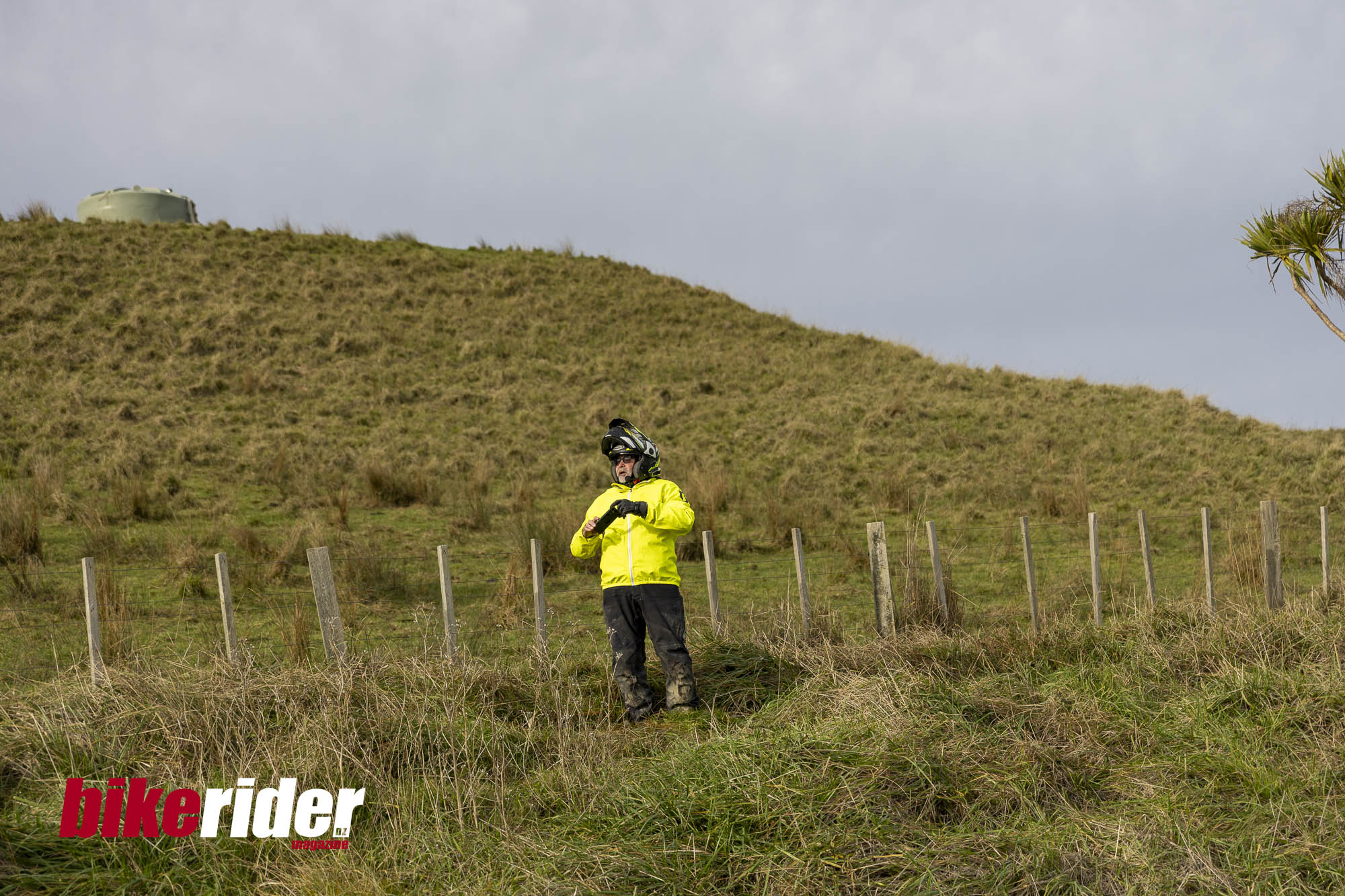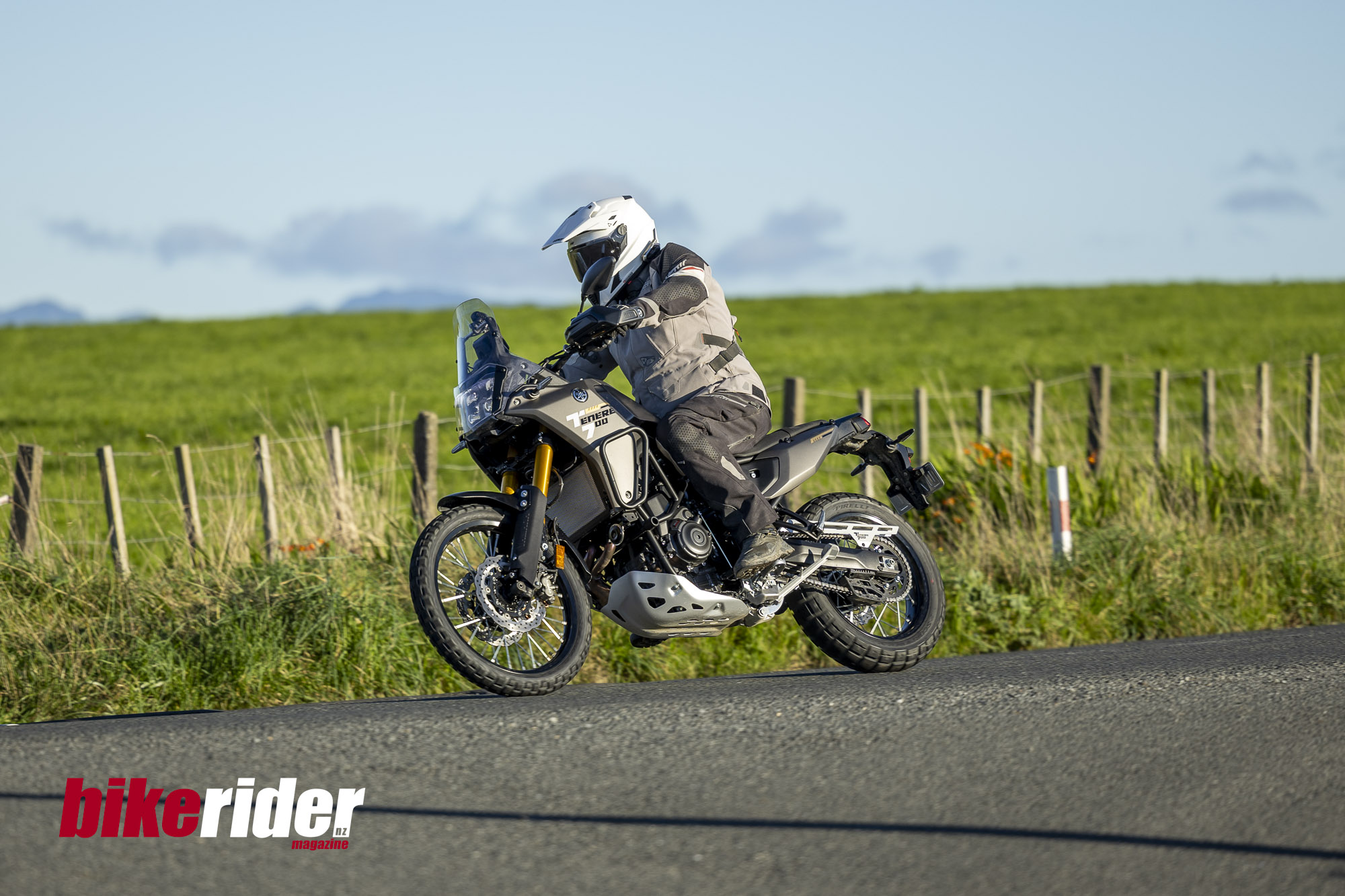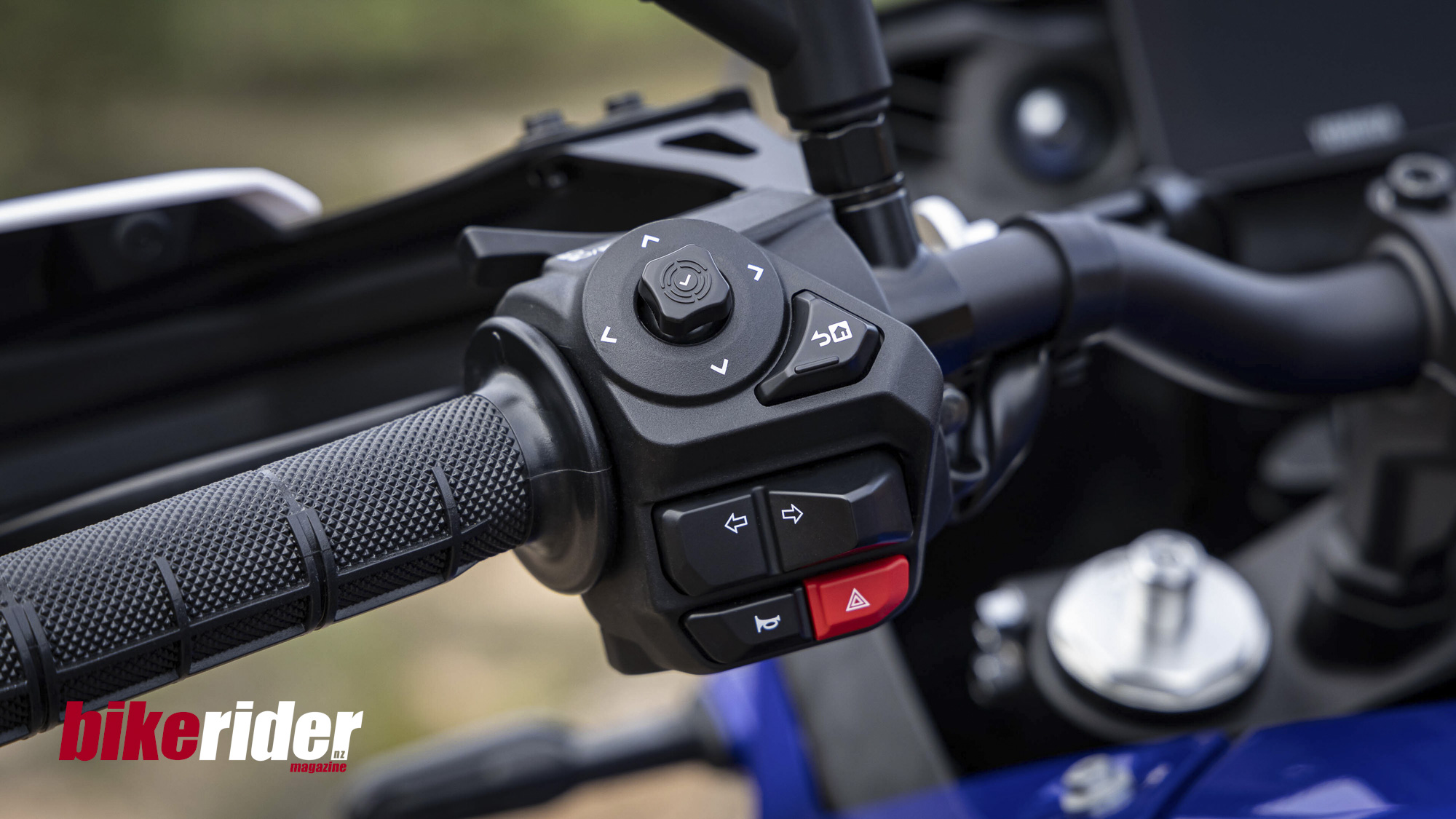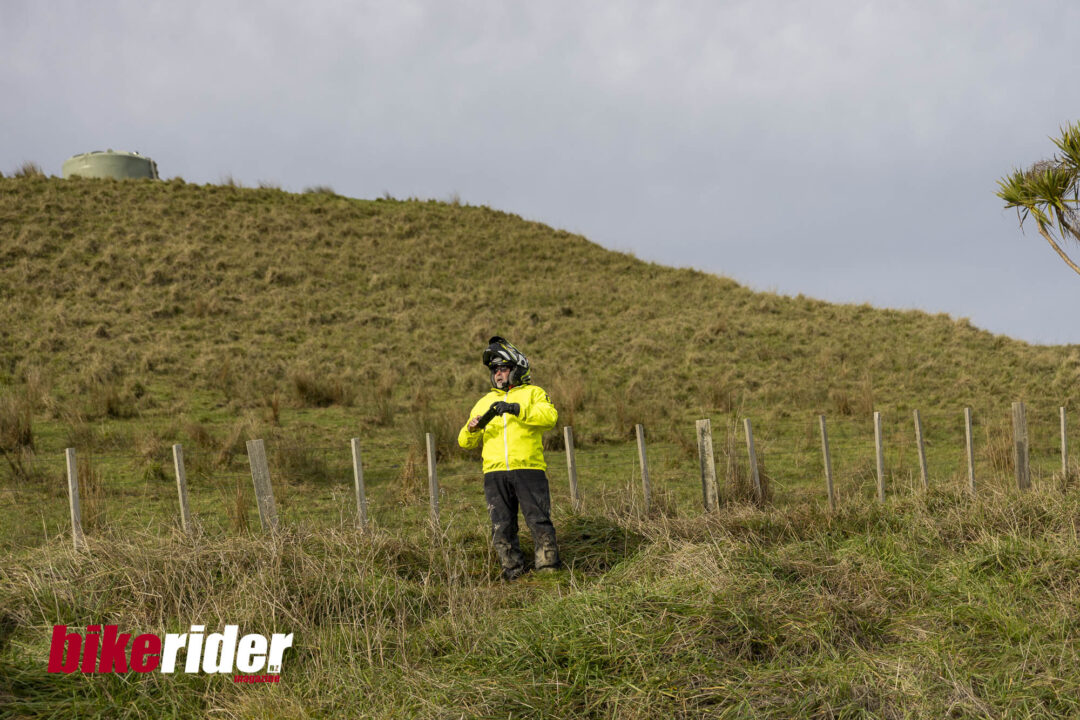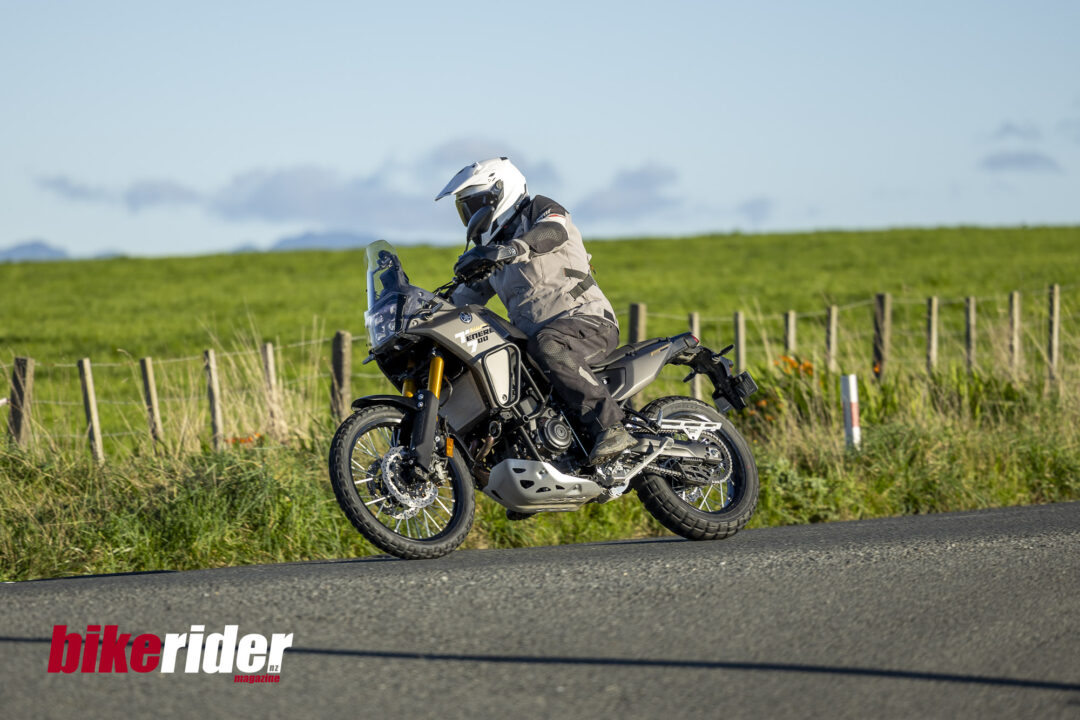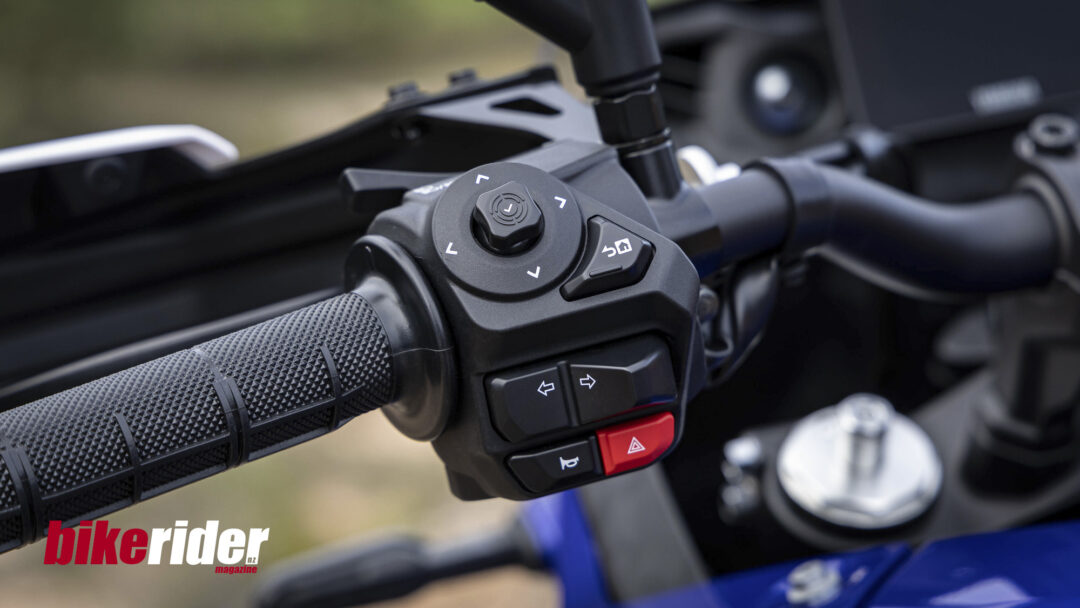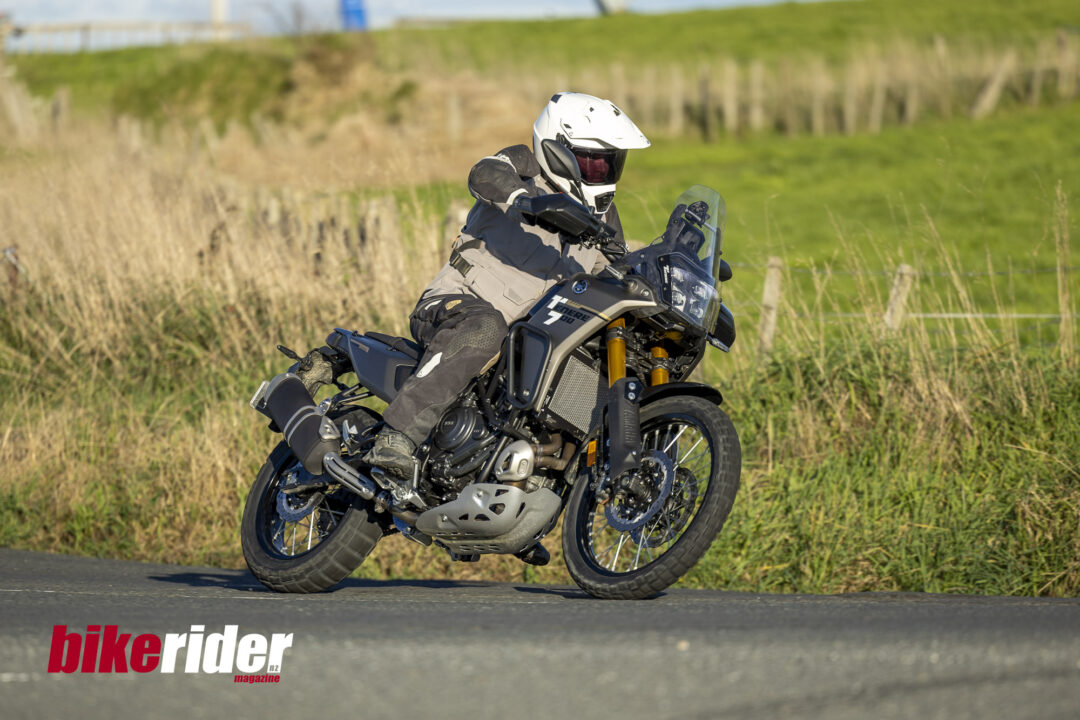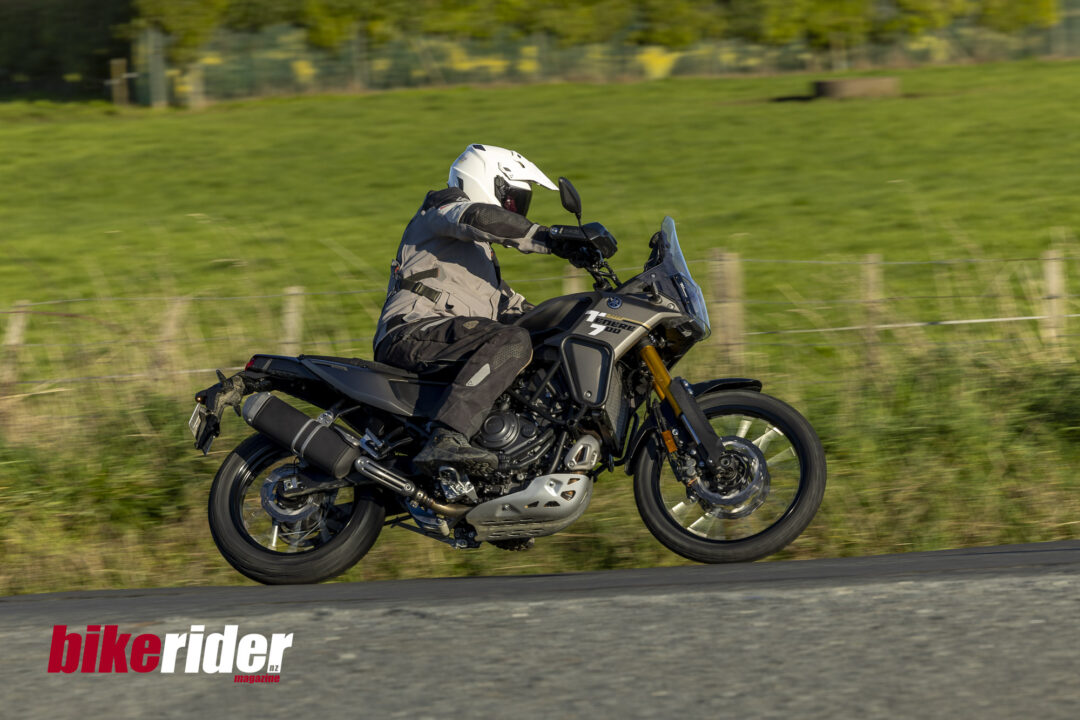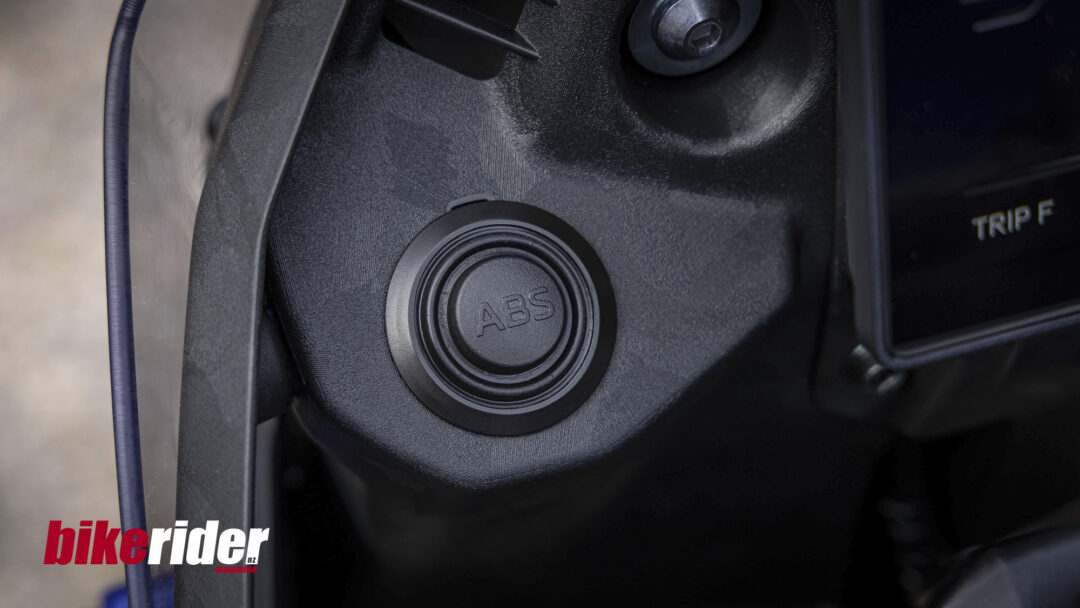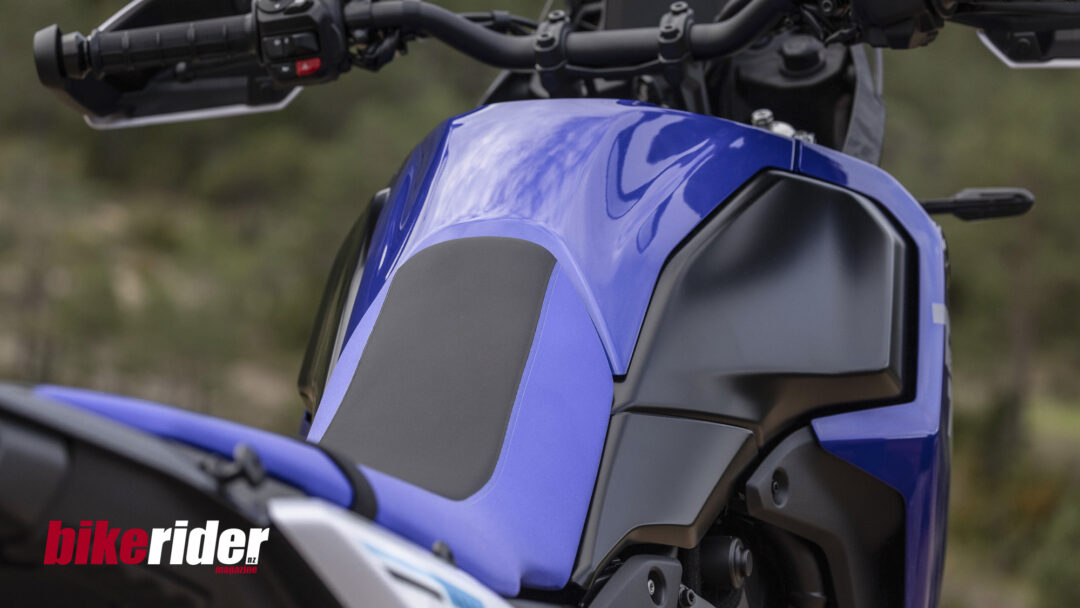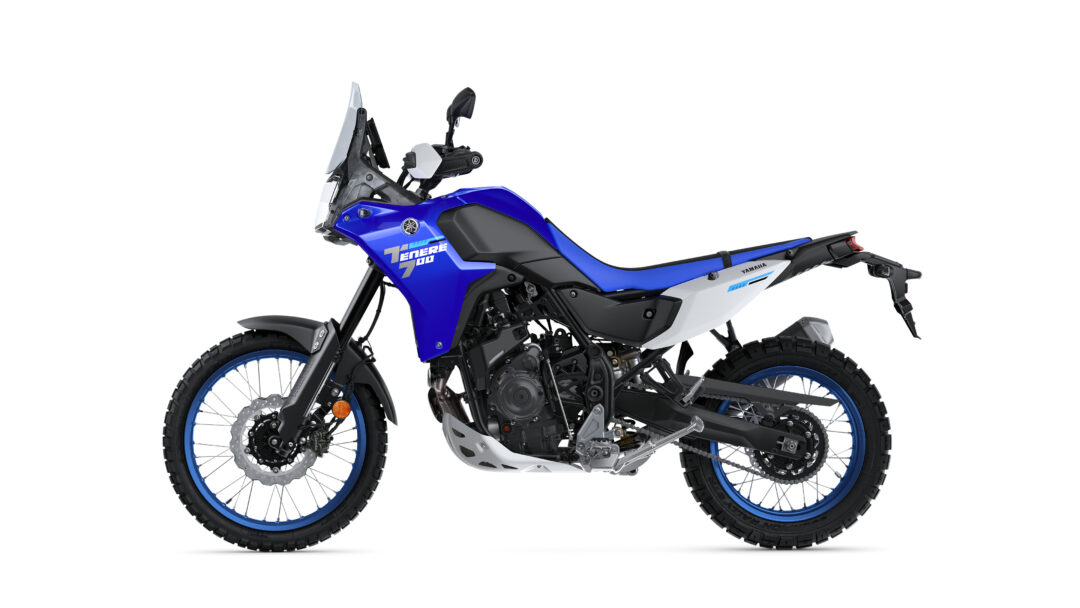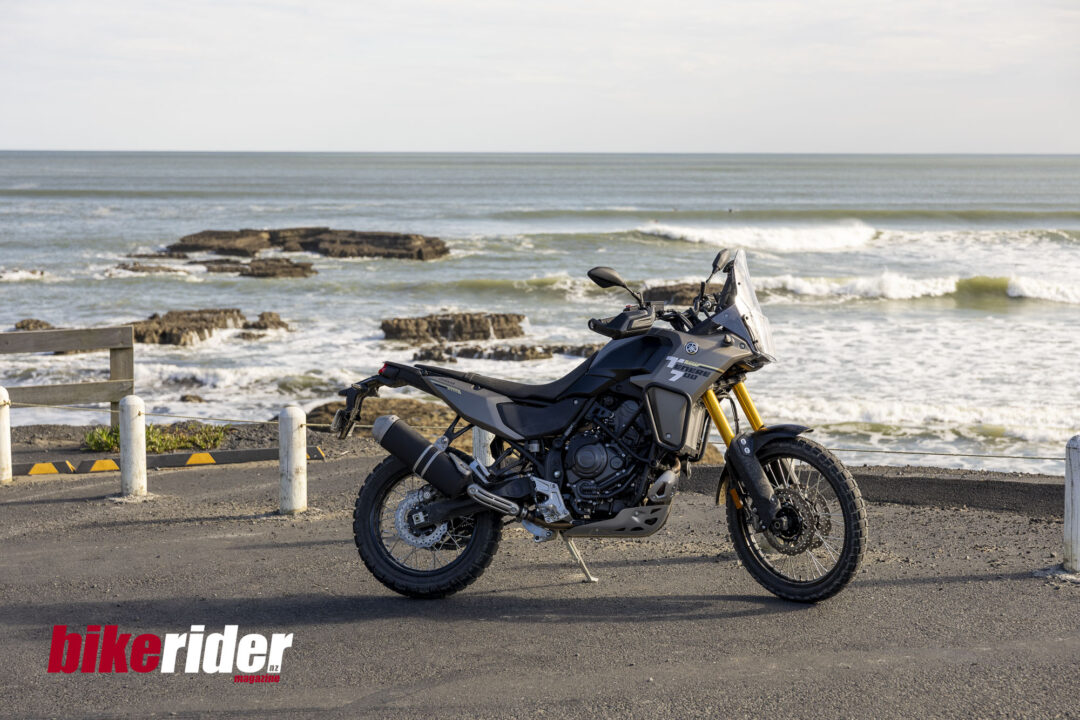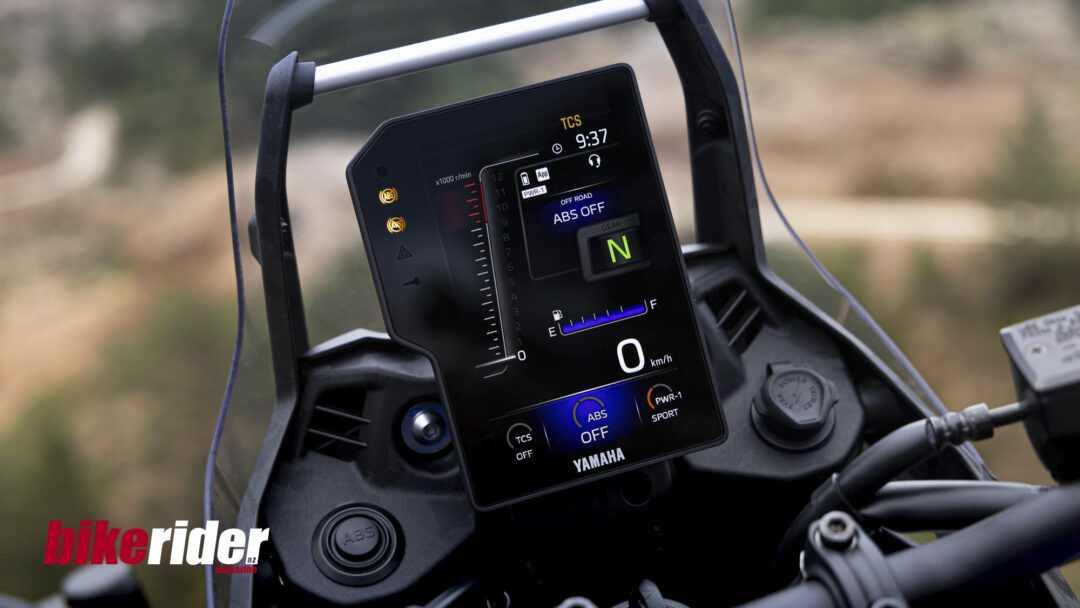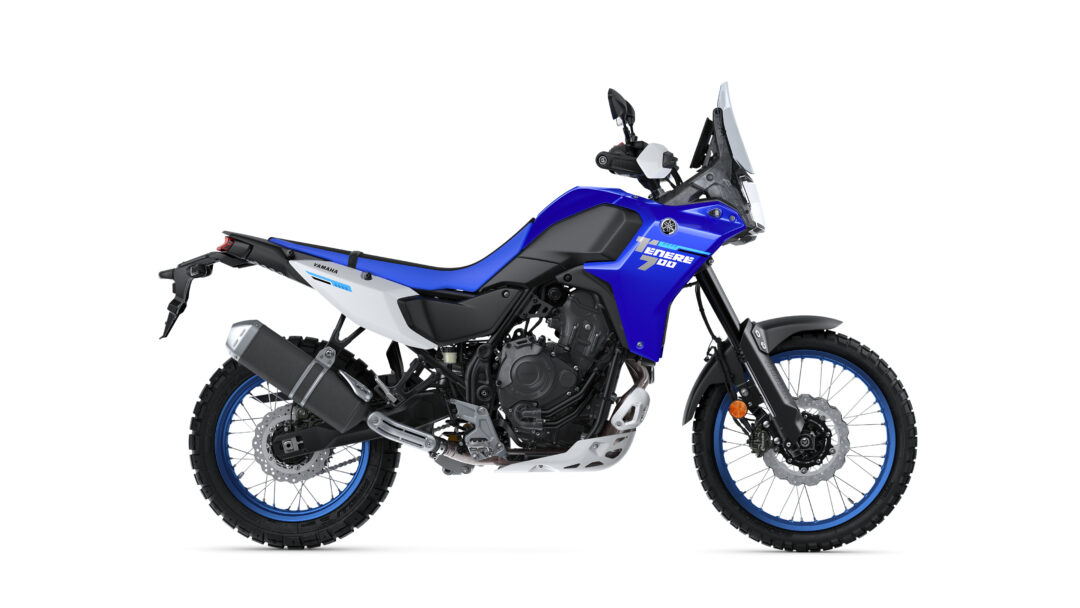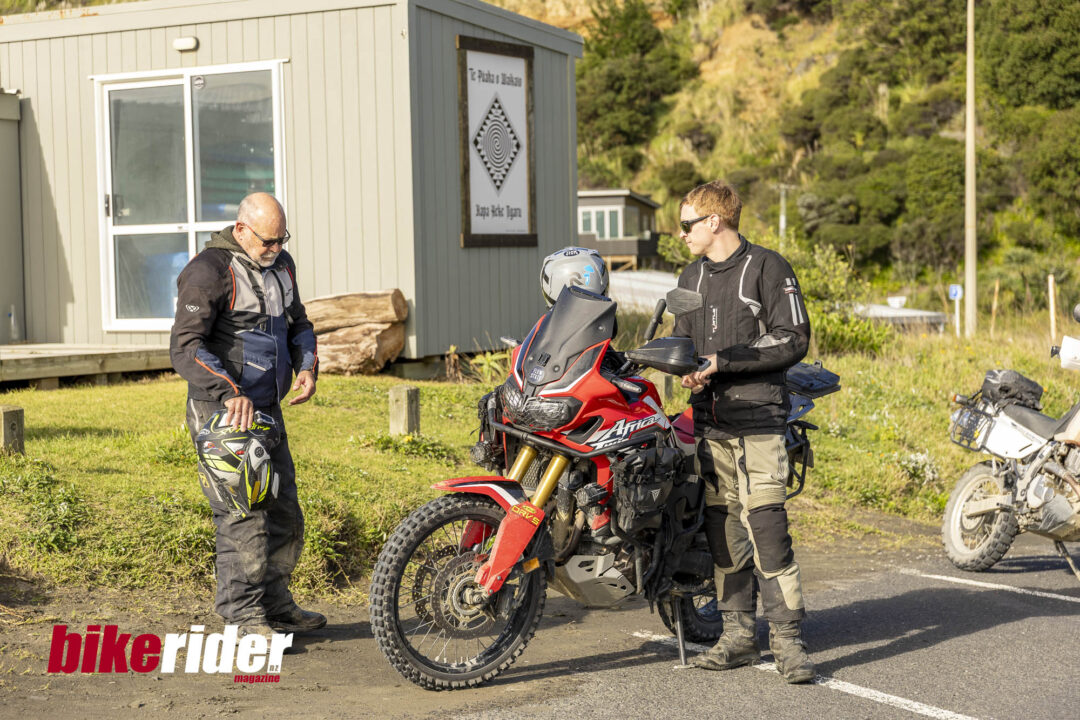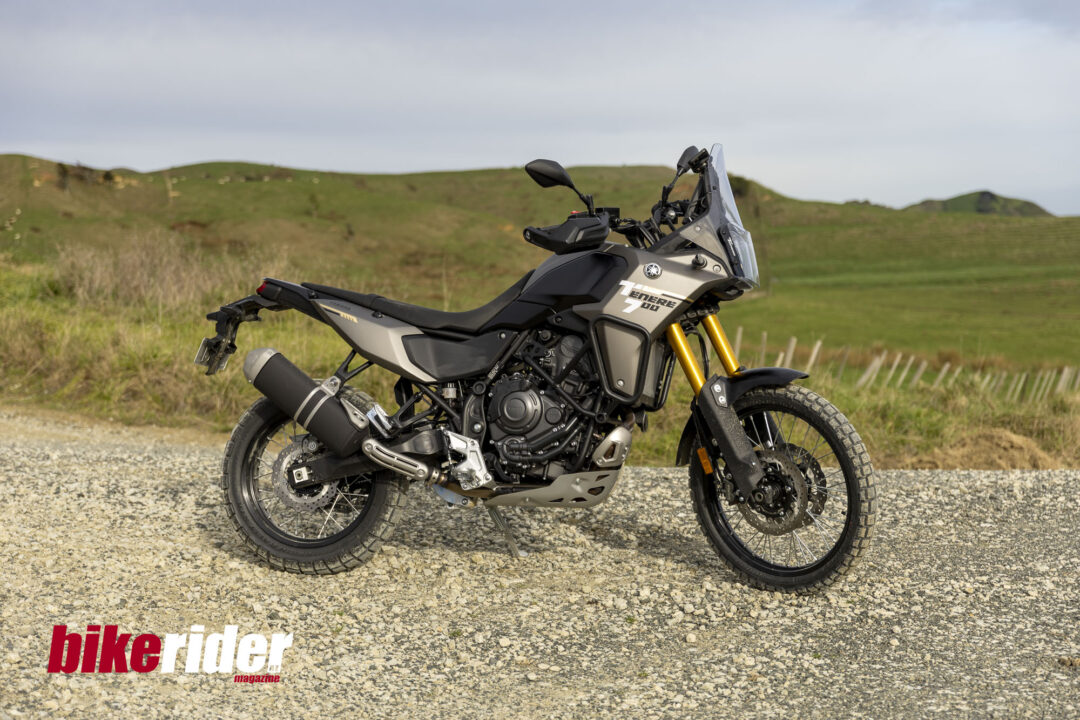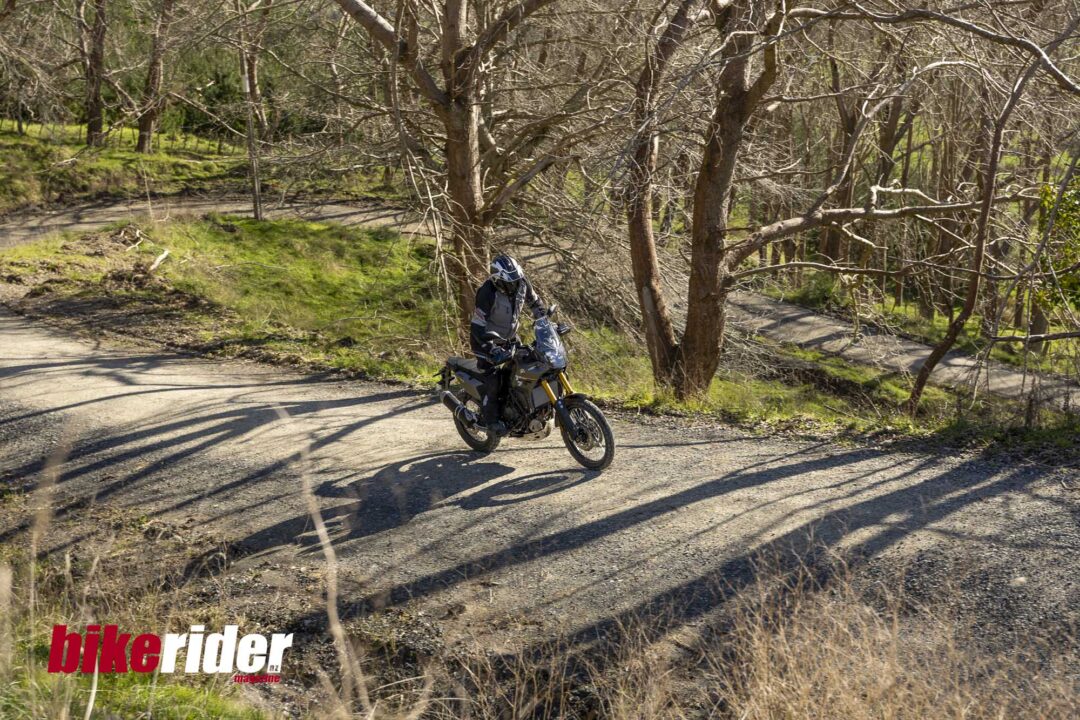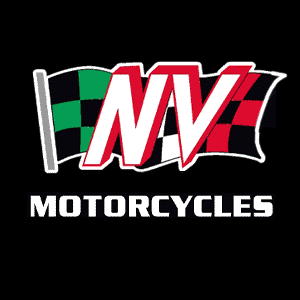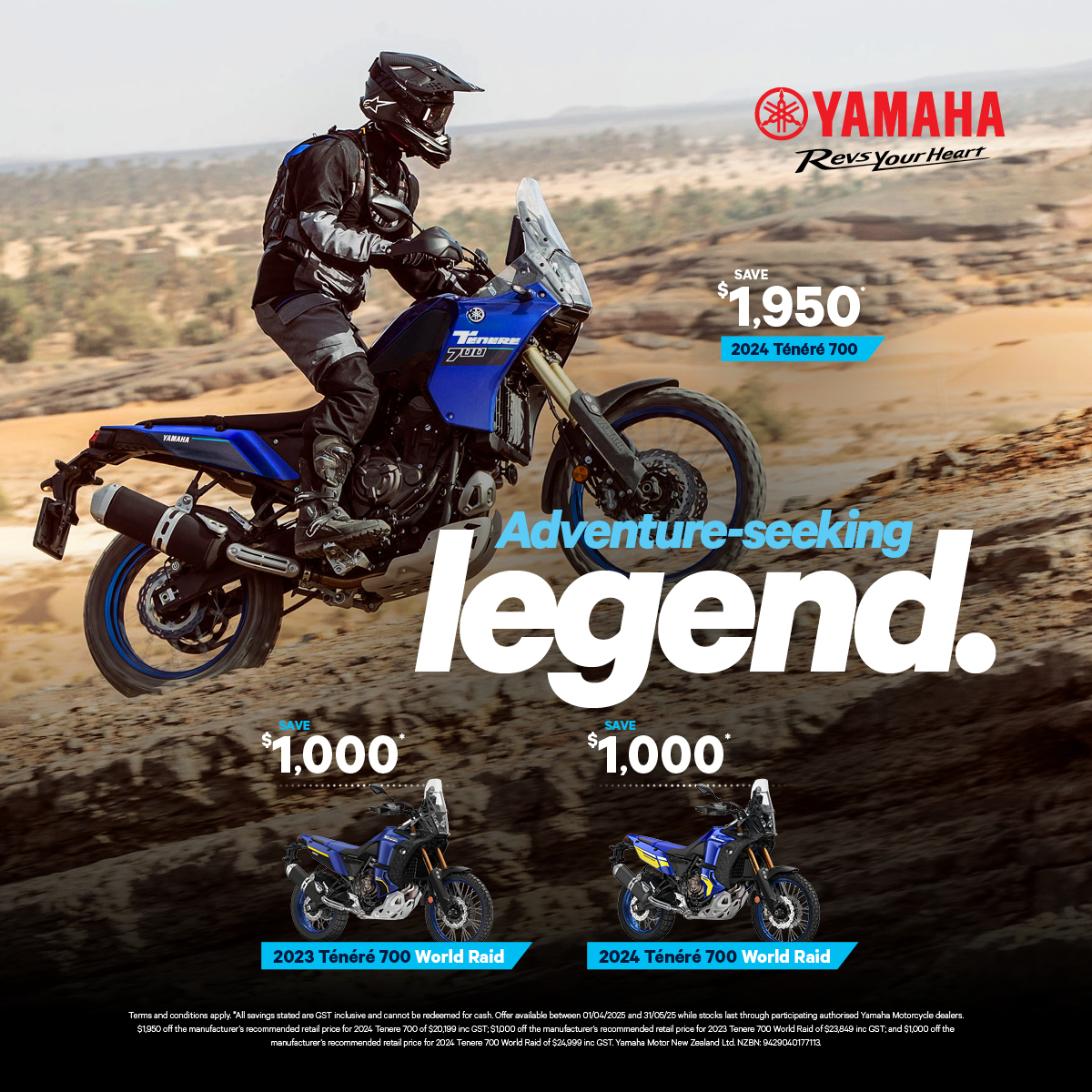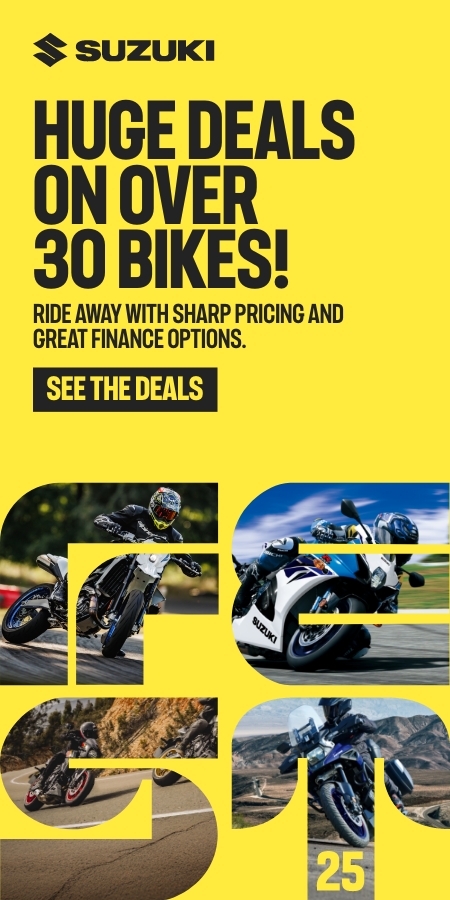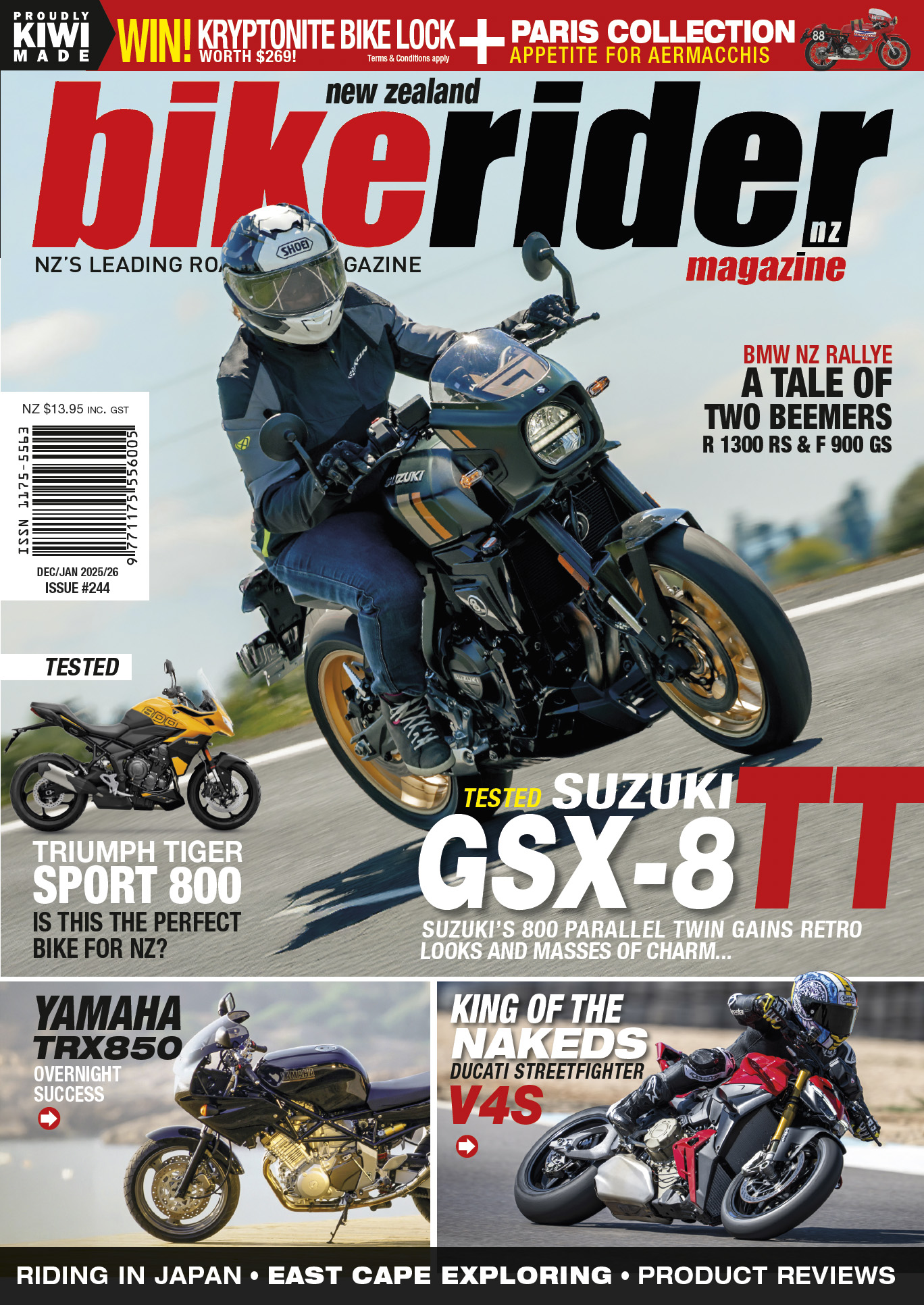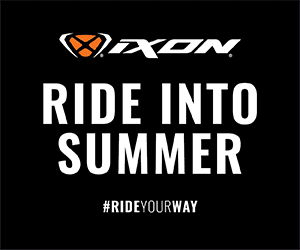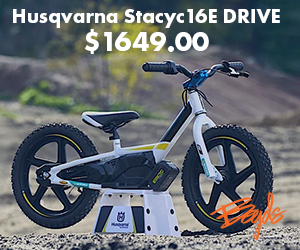- Yamaha has finally added electronics to the Ténéré 700 including mapping and traction control.
- CP2 powerplant remains the same. Yamaha has listened to feedback to make a host of changes.
- Now a lot easier to deactivate the rear ABS and the new swichgear is a welcome improvement.
Words: Paul Pics: Two Creative & Chris McKinnon
It’s often been regarded as the purist’s adventure bike, with the lack of electronic gizmos appealing to the riders that just want a bike to get on with the job. And the T7 certainly did that. Yet, we all knew that eventually the pressure to keep up with the rest of the increasingly tech-focused segment was going to get too much, and 2025 is the year the new Ténéré gets given a hefty update. But is it better? Paul hit the trails to find out…
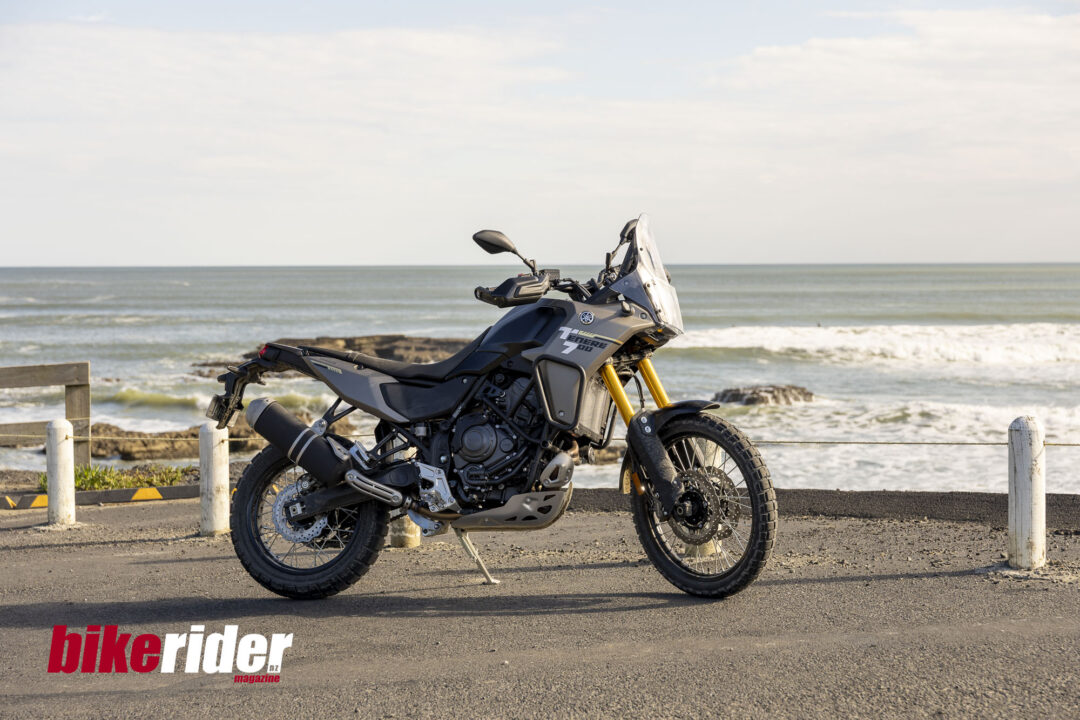
The T7 has always been a bit of an outlier in the adventure segment. At the original release in 2019, Yamaha claimed they wanted the Ténéré to be a stripped-back motorcycle that only features the basics, meaning there’s less to go wrong when you’re living your adventure life and riding in isolated environments. That meant no ride-by-wire, no throttle maps, no electronic suspension and no traction control, with the last aid apparently not required due to the linear power characteristics of the CP2, 689cc, parallel twin. Whether that was marketing spin to save cash or Yamaha was serious about the concept, I’m not sure. But the fact they sold T7s by the bucketload and it became known as a machine for serious adventure riders kind of proved that they knew their stuff.
Since then, the march of technology has continued its relentless journey in motorcycling, with the adventure category seemingly the favourite for the manufacturers to give us every available aid to assist us in our adventuring pastime. Adventure bikes I’ve tested recently feature multiple maps, cornering and off-road ABS, multiple traction control settings, and even push-button electronic suspension adjustment for when you decide you’re going to ride up a curb outside the local café. Thankfully, Yamaha hasn’t gone from one extreme to the other with the Ténéré 700, instead adding just enough in the electronics department to keep new owners happy while also, and more importantly, addressing a few of the niggles Ténéré owners have mentioned over the years. And it all seems to have come together and resulted in the best Ténéré 700 yet…
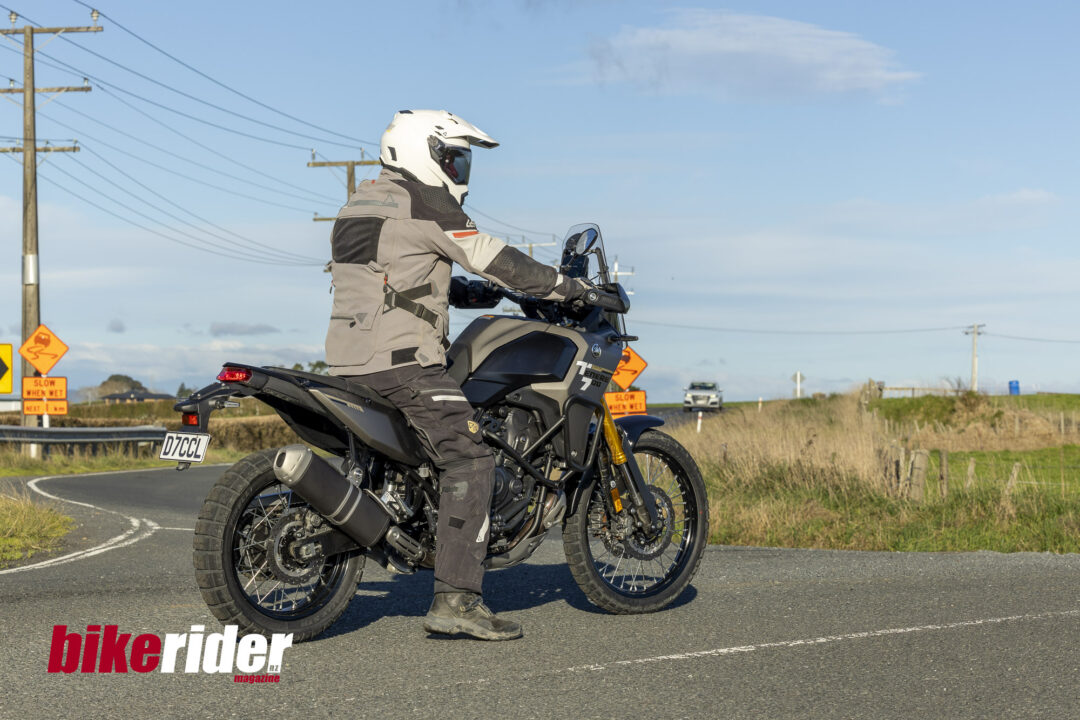
What’s Changed?
Earlier this year, I was invited to attend the NZ Yamaha Adventure Ride that consisted of three days of incredible adventure riding on the east coast of the North Island. I was given a Ténéré World Raid to ride, which is essentially a pimped standard Ténéré with a giant fuel tank – weirdly featuring two filler caps –, better suspension and bigger footpegs. It was excellent, and handled all the terrain of the ride organised by former MX World Champ Ben Townley with style and ease. And it’s a few of the parts that make the World Raid so good that have been transferred over to the base T7 to build on the platform.
Those bits include the all-important suspension, which holds a fair amount of sway in making the difference between a good and a great adventure bike. The standard T7 has always been regarded as good, but with the linkage taken from the World Raid and added to the shock of the base bike, while the 43mm USD forks also get revised internals and settings, the suspension package has had a serious revision. The forks feature 15mm of preload and are adjustable for compression and rebound, with a decent 210mm of travel available combined with 240mm of ground clearance. It’s a good update.
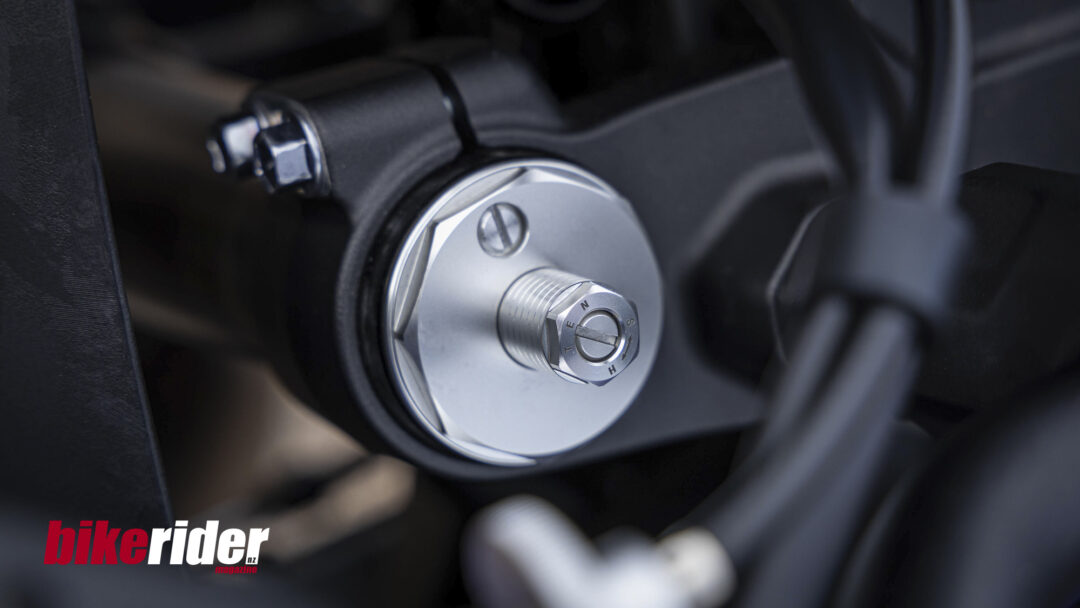
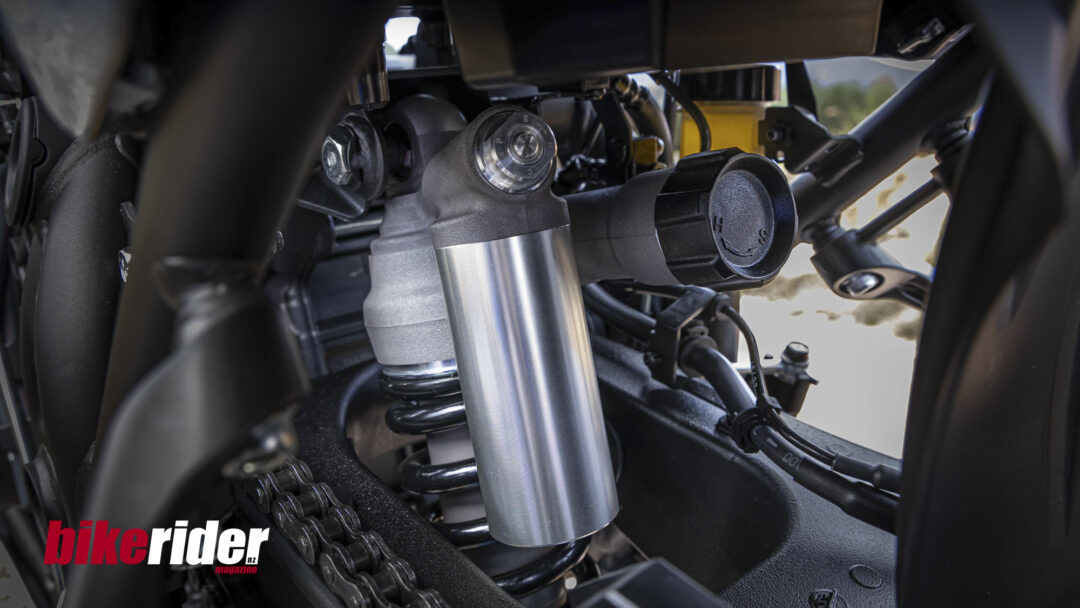
Another transfer from the WR are the excellent footpegs, with the large, purposeful pegs now another part that isn’t in need of an aftermarket upgrade once you get the bike home from the dealer. The rubbers are removable – Yamaha obviously knew I was going to get the bike dirty as they’d already removed them – and they work seamlessly with the revised ergos of the T7, which has seen a change to the engine on the right side where you always used to bang your shins. Shin banging no more…
Other tweaks and changes have also happened, including touches like strengthening the exhaust hanger, which used to break quite easily in a spill, apparently. The 16-litre tank retains the same capacity but sits slightly lower and further forward for better weight distribution while also making it easier to lean the bike over while standing up on the pegs. The riding position is nice and natural, with my knees able to push into the bike while standing to aid stability in cornering, and the bars feature a good bend. If anything, I’d roll them forward a touch, but nothing else.
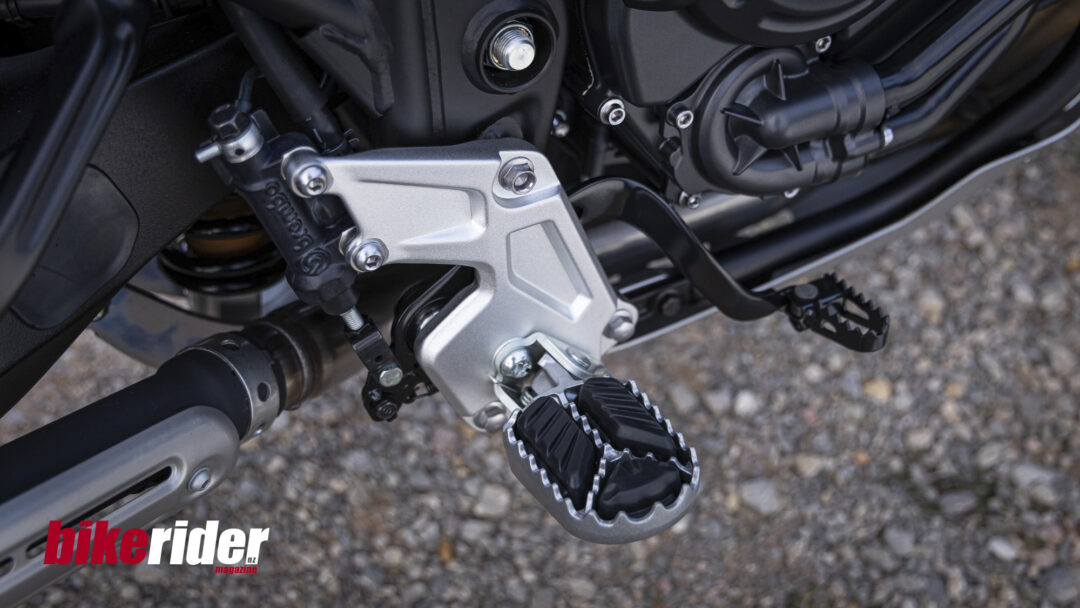
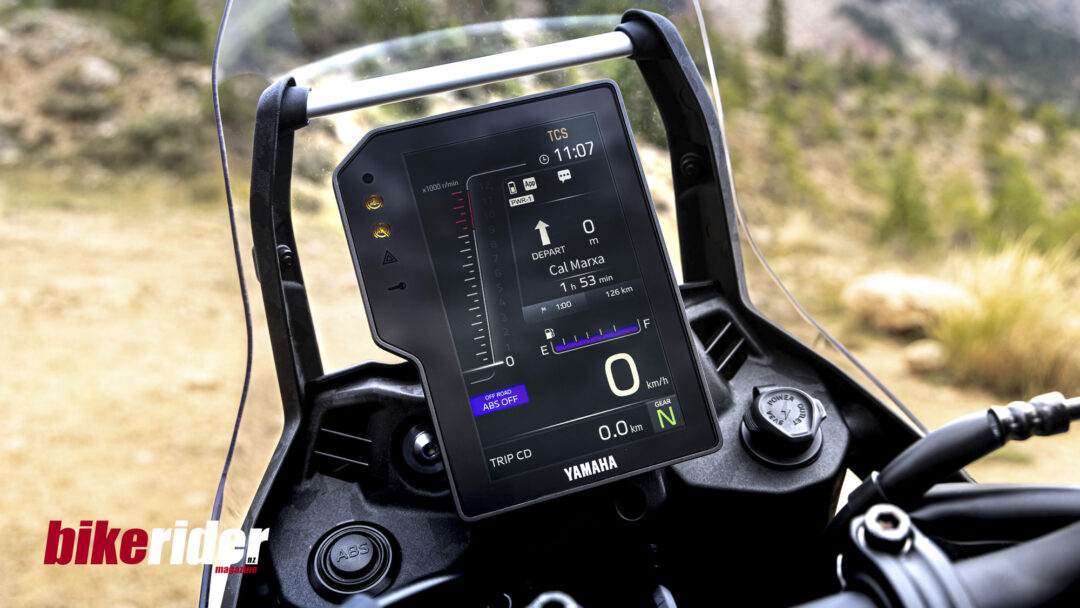
In the cockpit, there’s the new 6.3-inch TFT dash that’s the first thing everyone notices, meaning Yamaha owners finally no longer need to feel inadequate in the technology arms race. The dash is sweet, easy to read and comes with two layouts – Street and Explorer. It’s still ‘vertically staked’ like the LCD item of the original bike, but now you’ve got the ability to pair your smartphone to the dash, which is also now a whole heap easier than I’ve found on other Yamahas. All you need is the MyRide app on your phone and it scans to find the bike, then locate the QR code on the bike, scan it and the two start talking to one another – brilliant! Once linked, you can use the app for navigation with instructions coming up on the dash and it all works well.
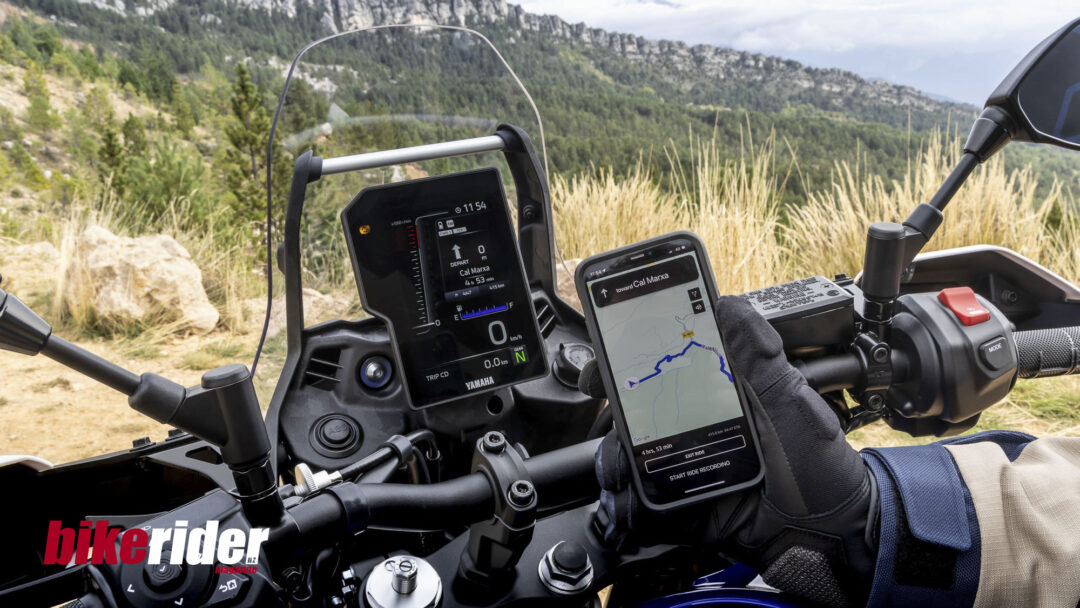
It’s the addition of the YCC-T (Yamaha Chip Controlled Throttle), though, that’s the real game changer, enabling Yamaha to now give the T7 switchable throttle maps, and there are two to choose from – Explore & Sport – along with traction control. They’ve also simplified the process of turning the ABS off, which was a real process on the previous model and has now been turned into a one-button push. The button is mounted to the left of the dash, making it easy to access, although you need to be stationary to disable the rear ABS with the push of the button. You can also disable the ABS front and rear, although that still requires a delve into the menus to get sorted the first time.
There’s no IMU on the Ténéré, so the aids aren’t lean-sensitive, and the traction control is offered with only two options, on or off. Getting into the menu to alter the settings is simple and easy, with the various options popping up at the bottom of the TFT screen, where you then use the toggle switch on the new switchgear that’s being rolled out across the range to adjust the various modes. Swapping the throttle maps requires a press of the Mode button on the right switchblock, with the modes highlighted once you’ve rolled off the throttle. When you’re under power, the options go dark, showing that you aren’t able to adjust them until you shut the gas.
Finally, the look of the Ténéré has been given a facelift, with a purposeful light featuring four individual LED lights stacked with a subtle Y-shaped mount in the middle. Not only does it look cool, it also provides decent coverage. And finally, the T7 now gets colour-matched handguards.
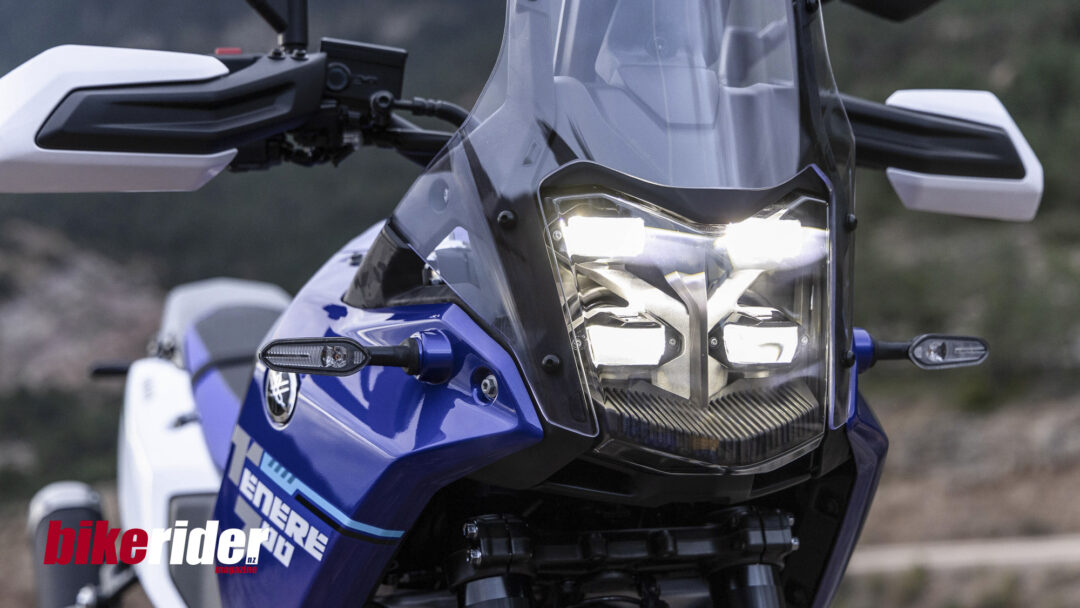
What’s It Like?
I first rode the T7 on a 5-day launch in Australia, which in itself showed just how important this model was for Yamaha – no one puts on 5-day launches nowadays. And the riding was EPIC, spent crossing large swathes of northern New South Wales usually at high speeds and regularly in 40-degree heat, sampling the excellent adventure capability of the machine. And, despite the reservation that it was fitted with the MT-07 powerplant and ‘only’ had 70-ish horsepower, what the T7 lacked in grunt it more than made up for in the way it felt like a grown-up dirt bike rather than a road bike tweaked to be able to tackle a bit of dirt. It was magic.
Fast forward half a decade, and I’m jumping on the 2025 T7 and slipping on my IXON heated gloves, while the new TFT dash tells me the air temp is sitting at the low end of single figures. Yep, this test was going to be a bit different to the original. Still, meeting a couple of guys mid-week from the local adventure riders social group meant that we could have a day testing the Yamaha on some excellent gravel roads in relative isolation, with not many others out mid-week in the middle of winter.
The beauty of the CP2 powerplant in the T7 has always been its linear power delivery and flexible nature, something I noticed had instantly changed with the new bike. The connection of the throttle to the motor seemed ‘digital’, with an instant response coming from the smallest of movements with my throttle hand. Checking the dash and I soon realised the T7 was set in Sport mode, and for once, the Ténéré actually felt sporty. Okay, it was a bit lively for cruising through inner-city traffic, but I was amping to give it a go out on the trails where the previous version had always lacked a bit of ‘bark’.
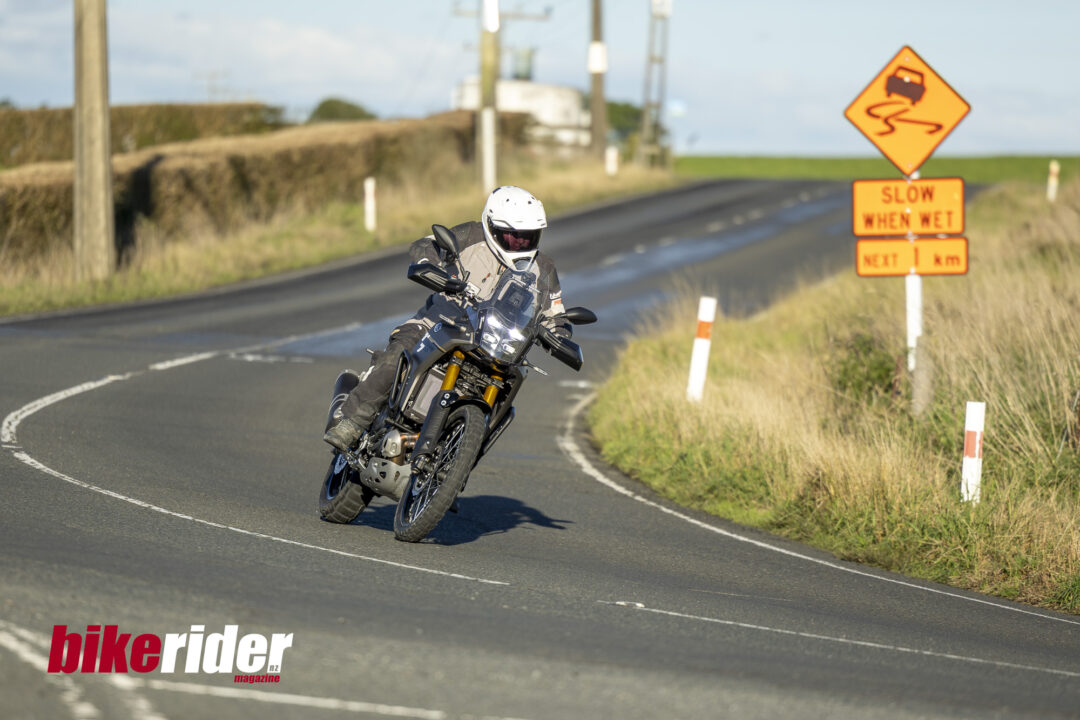
Dropping into Explore and the response is instantly dulled, with the 73hp and 68Nm now feeling much more controlled in the close confines of a commute. With the sit-up riding position giving a dominating view of my surroundings, it’s not long before I was cutting through traffic and enjoying the newfound composure in the suspension. Whereas the previous model felt like it would easily blow through the stroke of the suspension, the new bike feels much better suspended, although it’s noticeable that the T7 feels taller in the saddle, probably due to the suspension not compressing quite so much.
Getting my head around the new layout and settings took a while and a bit of help from the youngest member of our group (I bet he couldn’t program a video recorder though…), and it wasn’t long before I had the Ténéré dialled in for a bit of fun. Our route took us from Hamilton up the western side of the North Island. And while there’s the popular route of the main coast road, which is an excellent stretch of twisting gravel, our lead rider had mapped out a ride that took us up to the famous Nikau Caves for lunch and then on to Port Waikato. And while I expected to be stuck on SH22 (which is an excellent sealed road) for the journey home, he had another bunch of gravel roads planned that saw us probably only spend 20% of the 250km journey on tarseal. And it was EPIC!
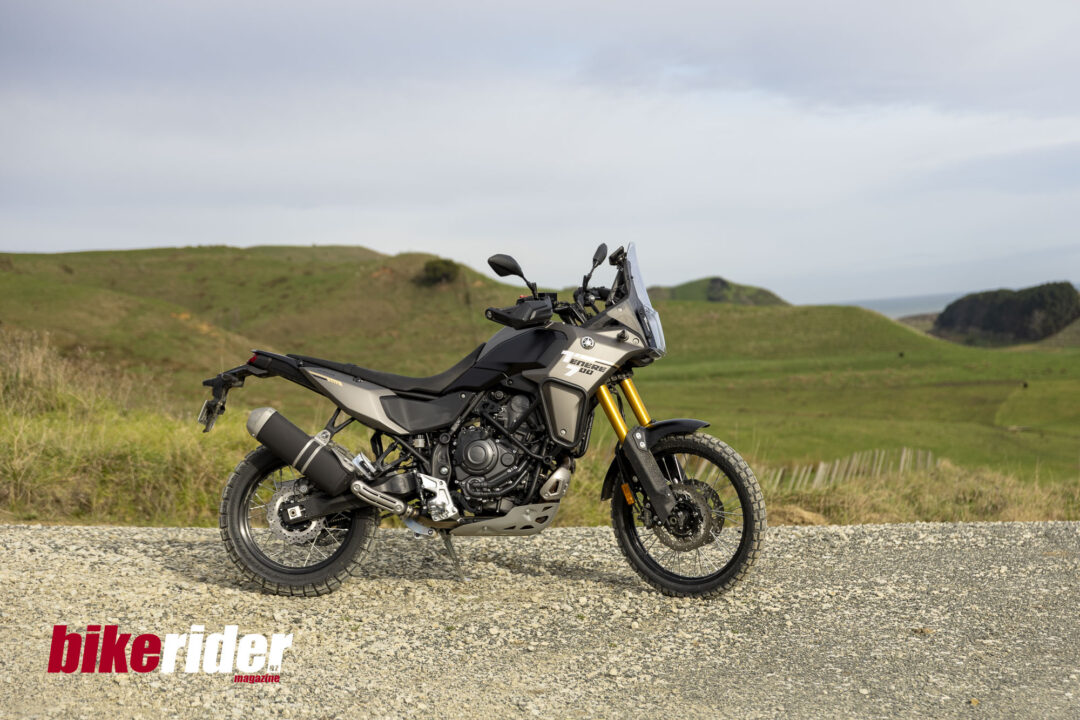
Dirt Duties
The first gravel section saw me instantly work out that Sport mode was where I wanted to be (why they didn’t call it Gravel mode I’ve no idea…), with a swap done quickly while off the throttle on a downhill section. And the change is remarkable. Whereas Ténéré riders have grown accustomed to having to swap exhausts and get remaps done to give the friendly CP2 parallel twin a bit of mongrel, now all you need to do is switch maps, and the T7 instantly feels like a different bike. Getting the real wheel to spin up to aid steering when exiting a corner is now a breeze, and while the output doesn’t change from the twin, the T7 feels a whole lot more aggressive. It’s great.
To get that rear wheel to spin means deactivating the traction control, as dialling in the throttle with it switched on simply offers loads of drive, with the Yamaha system somehow capable of still working on a loose surface. Corrugations on corners heading uphill still send it into a bit of a flap, but not like others where the system simply shuts all the power down. Instead, the Ténéré is easily rideable on loose surfaces with the TC switched on, and it’s only when you’re on seriously slippery surfaces or you want to have a bit of fun that you really need to turn it off.
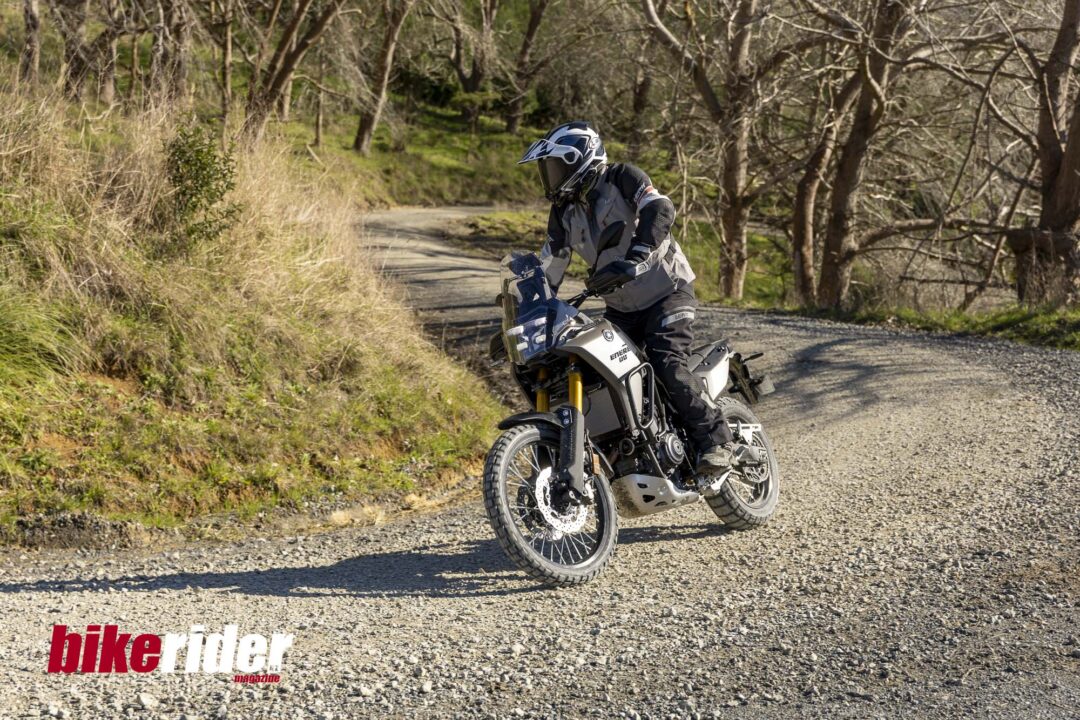
When you do decide you want to switch the TC off, you don’t need to enter the menu each time as it’s linked to the ABS button. So if I had bothered to activate the ABS and TC for a long road section, a quick stop for a single press of the ABS button deactivates the ABS and the TC at the same time, making it an easy task.
Standing up on the pegs reveals what a game-changer the new pegs are, with not only more control but also more comfort compared to the original small items. And with the suspension now offering more support, the entire package encourages you to ride faster and hit things harder, while the motor still offers its flexible delivery, just with a bit more urgency as you get back on the gas from a closed throttle. The twin discs up front, gripped by twin piston Brembos, looked like they might offer a bit more stopping power than you might want on loose surfaces, but I was finding one or two fingers were all that was required to scrub speed on the gravel and the tarseal. The rear wasn’t quite so encouraging with a decent jap with my large Leatt boot required to get the Pirelli to lock up, although with only 24km on the clock when I left Hamilton, chances are the pads would start performing better after they’d bedded in some more.
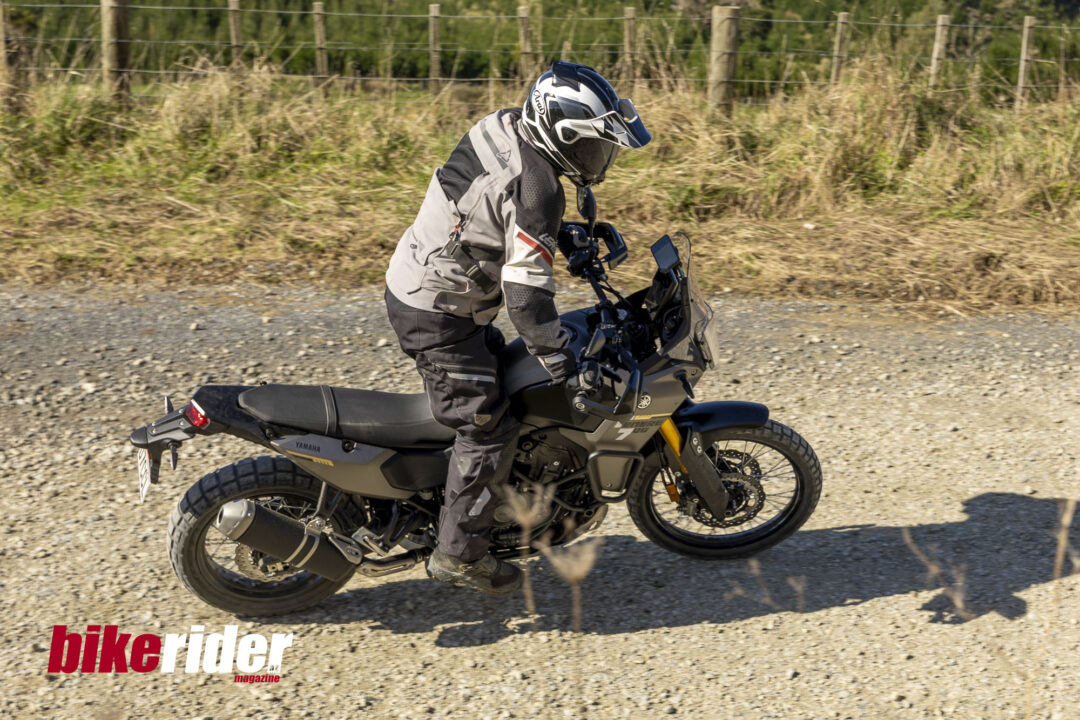
Verdict
I reckon the Ténéré 700 has always been the ‘sleeper’ of the adventure world. Many dismissed it for its low maximum output and lack of electronics, but those in the know were aware of just how capable the Yamaha was when you really wanted an adventure. Since its launch, Yamaha has obviously kept an eye on the chatrooms and seems to have pretty much solved all the niggles and moans with this update. It’s hard to say what they’ve missed on improving until riders start heading off into the wilds and put it through its paces in some tougher terrain. The addition of the electronics, while not overwhelming in scale, is enough to keep prospective buyers happy, I reckon, while also offering an instant snap of power that’s been sorely missing.
The tweaks to the ergos, like the large pegs and updated suspension, undoubtedly make the T7 even more accomplished riding off-road if that’s your thing, although if you struggled with the height of the previous version, you’ll probably want to opt for the low seat version of this one as it felt taller than ever to me. At 182cm tall, I was still feeling a little stretched to reach the floor.
What hasn’t changed is the versatility that’s become the trademark of the Ténéré 700, with the new model feeling like a workhorse that’s now been updated with all the bells and whistles. And while I’m sure many riders don’t need the option to read messages from their phone on the dash, the ability to swap throttle maps and quickly and easily disable the ABS and traction control is, I reckon, enough of an advantage to make this the T7 that not only Ténéré fans will be drooling over but also other adventure riders who know their stuff.
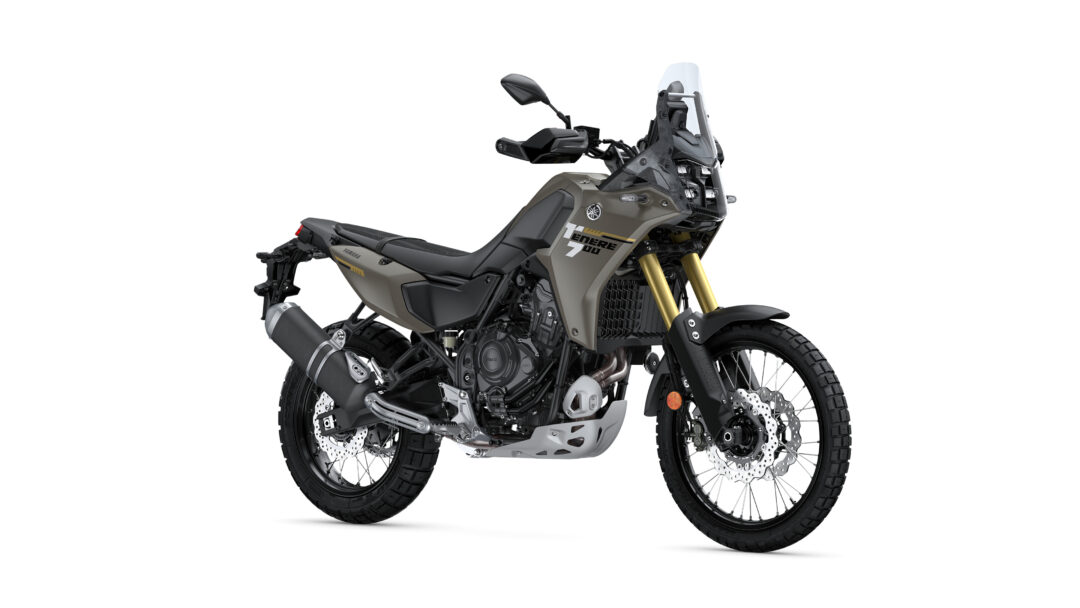
2025 Yamaha Ténéré 700 – New Technical Highlights
▪ New bodywork and headlight
▪ High quality, fully-adjustable suspension front and rear
▪ New 6.3in full colour TFT screen with smartphone connectivity
▪ YCC-T electronic throttle with dual riding modes
▪ Switchable ABS and TCS via a dedicated button
▪ Latest version 690cc, two-cylinder, four-valve, DOHC, liquid-cooled, CP2 engine
▪ New switchgear and turn signals
▪ New one-piece rally-style seat
▪ New clutch cover to reduce leg interference
▪ Larger footrests
▪ Handguards matching body colour
▪ Updated side stand switch
Gallery: 2025 Yamaha Tenere 700
Specifications
2025 Yamaha Ténéré 700
Price: $20,199 Ride away
Engine Type Liquid-cooled, 4-stroke, DOHC, 4 valve, 2-cylinder
Displacement (cc) 689.0
Bore x Stroke (mm) 80.0 x 68.6
Compression Ratio 11.5 : 1
Lubrication System Wet Sump
Fuel Management Fuel Injection
Ignition TCI
Starter System Electric
Fuel Tank Capacity (L) 16.0
Final Transmission Chain
Transmission Constant mesh 6-speed
Frame Type Double cradle steel tube
Suspension Front Upside down telescopic fork, 210mm travel
Suspension Rear Swingarm (link suspension), 200mm travel
Brakes Front Hydraulic dual discs, 282mm, ABS
Brakes Rear Hydraulic single disc 245mm, ABS
Tyres Front 90/90 R21 M/C 54V
Tyres Rear 150/70 R18 M/C 70V
Length (mm) 2370
Width (mm) 935
Height (mm) 1455
Seat Height (mm) 875
Wheelbase (mm) 1595
Ground Clearance (mm) 240
Wet Weight (kg) 208
Contact www.yamaha-motor.co.nz
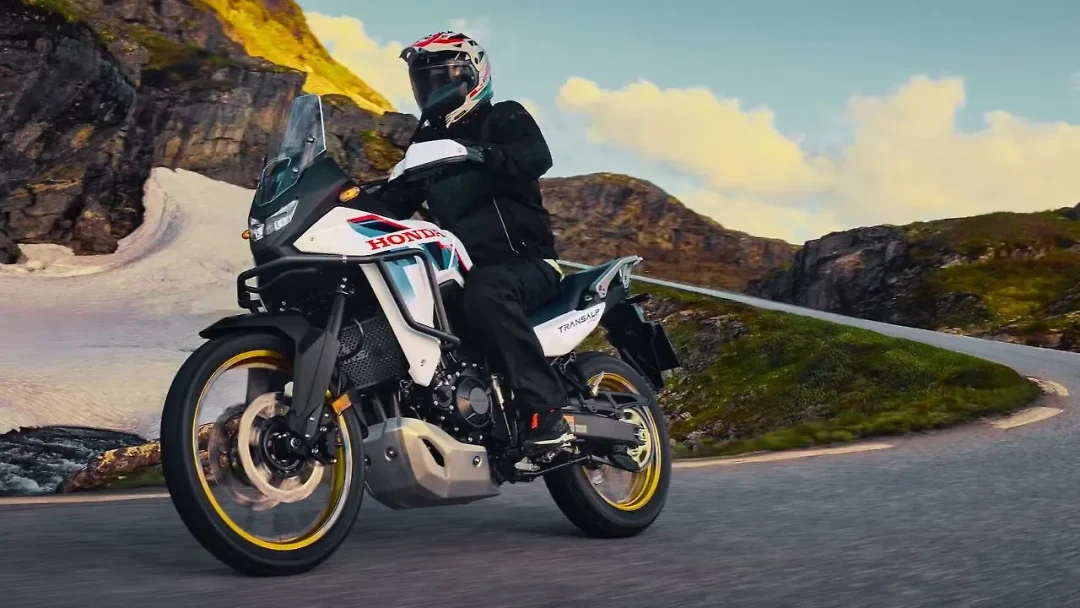
Yamaha Ténére 700 vs Honda Transalp 750
On paper, the closest rival to the new Yamaha Ténére 700 would be the Honda Transalp 750. While the Ténére has a stronger off-road focus with simpler electronics and lighter feel, the Transalp leans more toward road comfort, touring ability and everyday usability. For Kiwi riders who spend more time on sealed backroads with the occasional gravel detour, the Transalp makes a strong case, while the Ténére remains the pick for riders prioritising gravel and off-road riding.
How does the Honda Transalp 750 compare to the Yamaha Ténére 700 for NZ riding?
Hitting the trails and gravel on the Yamaha, the bike feels much more designed to tackle a bit more adventure than the Honda. The uprated suspension of the Ténére has you able to hit obstacles harder without bottoming through the stroke, while the Honda feels like it’s more designed for road riding with a bit of off-road on the side.
Another difference is the gearing, with the Honda very much geared for high speed cruising. The Yamaha, with the ride-by-wire throttle and new maps gives a much more aggressive burst of power when you open the throttle, whereas the Honda needs a gear to be dropped (or two) and the revs to be sitting higher around the dial. Keep the revs up and the Honda responds well with the power from the Hornet power plant, but it’s not a torque monster.
Something that might appeal to riders is the new E-Clutch version of the Honda Transalp, with the system allowing you to operate the bike without using the clutch, even when stopping, starting or shifting gear. This will aid the Transalp rider off-road as they won’t be worried about stalling the bike or releasing their grip on the handlebar to use the clutch. But, with the Honda system, there is a clutch still there. So if you need an instant burst of power to lift the front 21-inch wheel over something, you still can. We rode the Honda E-clutch CBR650 HERE and it performed well, if taking a little while to get used to.

